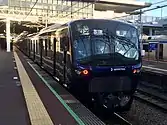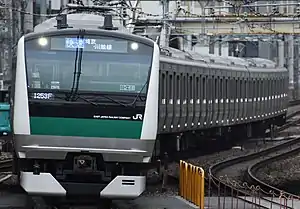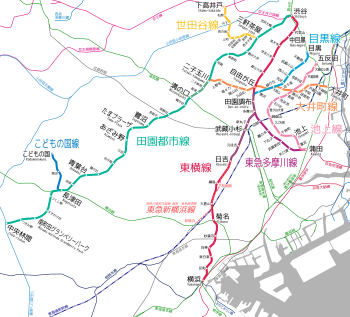Sōtetsu Shin-Yokohama Line
The Sōtetsu Shin-Yokohama Line is a rail link from Nishiya Station on the Sōtetsu Main Line (operated by Sotetsu) to Hiyoshi Station on the Tōkyū Tōyoko Line (operated by Tōkyu Corporation) passing Yokohama-Hazawa Station on the JR Tōkaido Freight Line, and via Shin-Yokohama Station.
| Overview | |||
|---|---|---|---|
| Other name(s) | Sōtetsu JR Link Line (相鉄・JR直通線) (Nishiya - Hazawa Yokohama-Kokudai) Sōtetsu Tōkyū Link Line (相鉄・東急直通線) (Hazawa Yokohama-Kokudai - Shin-Yokohama) | ||
| Native name | 相鉄新横浜線 | ||
| Owner | Japan Railway Construction, Transport and Technology Agency | ||
| Locale | Yokohama, Kanagawa, Japan | ||
| Termini | Nishiya Shin-Yokohama | ||
| Stations | 3 | ||
| Service | |||
| Operator(s) | Sagami Railway | ||
| History | |||
| Opened | 30 November 2019 (Nishiya - Hazawa Yokohama-Kokudai) Late 2022 (Hazawa Yokohama-Kokudai - Shin-Yokohama) | ||
| Technical | |||
| Line length | 6.3 km (3.9 mi) | ||
| Number of tracks | 2 | ||
| Track gauge | 1067 mm | ||
| Electrification | Overhead catenary 1,500 V DC | ||
| |||
| Overview | |||
|---|---|---|---|
| Other name(s) | Sōtetsu Tōkyū Link Line (相鉄・東急直通線) | ||
| Native name | 東急新横浜線 | ||
| Owner | Japan Railway Construction, Transport and Technology Agency | ||
| Locale | Yokohama, Kanagawa, Japan | ||
| Termini | Shin-Yokohama Hiyoshi | ||
| Stations | 3 | ||
| Service | |||
| Operator(s) | Tokyu Corporation | ||
| History | |||
| Planned opening | Late 2022 | ||
| Technical | |||
| Line length | 5.8 km (3.6 mi) | ||
| Number of tracks | 2 | ||
| Track gauge | 1067 mm | ||
| Electrification | Overhead catenary 1,500 V DC | ||
| |||
The section between Nishiya and Shin-Yokohama (to be operated by Sōtetsu) will be named the Sōtetsu Shin-Yokohama Line (相鉄新横浜線, Sōtetsu Shin-Yokohama-sen), while the section between Shin-Yokohama and Hiyoshi (to be operated by Tōkyū) will be named the Tōkyū Shin-Yokohama Line (東急新横浜線, Tōkyū Shin-Yokohama-sen).[1] Both operators will be putting their company names as a formal part of the line names, which is a first for Sōtetsu, and a second for Tōkyū (the first being the Tōkyū Tamagawa Line).
This page also explain the two through service lines, namely the Sōtetsu JR Link Line (相鉄・JR直通線, Sōtetsu JR Chokutsū-sen), and the Sōtetsu Tōkyū Link Line (相鉄・東急直通線, Sōtetsu Tōkyū Chokutsū-sen).
The Sōtetsu JR Link Line opened on 30 November 2019 and it has been announced that the Sōtetsu Tōkyū Link Line will open in late 2022.[2]
Project summary
The following information is what has been announced before January 2019.
This 12.7 km link line is under construction between Nishiya on the Sōtetsu Main Line to Hiyoshi on Tōkyū Tōyoko and Meguro Lines. The stations to be set up along the line are namely: Hazawa Yokohama Kokudai (near Yokohama-Hazawa Station on JR Tōkaido Freight Line), Shin-Yokohama (Provisional), and Shin-Tsunashima (near Tsunashima Station on the Tōkyū Tōyoko Line).
It has been planned that Sōtetsu Main Line and Sōtetsu Izumino Line trains will operate through services with JR East via Hazawa Yokohama Kokudai; and with Tōkyū, Toei Subway Lines via Hiyoshi. The former will be named the Sōtetsu JR Link Line, and the latter will be named the Sōtetsu Tōkyū Link Line, and these two lines make up the Kanagawa Eastern Line. Moreover, Sōtetsu has been promoting the project as the "Metropolitan Direct Linkage Project" (都心直通プロジェクト), as the link will enable connection from eastern Kanagawa into central Tokyo, and further north towards Saitama.
Regarding the Sōtetsu JR Link Line, Hazawa Yokohama Kokudai Station will be jointly operated by JR East and Sōtetsu. This is a first for JR East to operate commuter trains with other operators aside from Tokyo Metro.[note 1]
For the Sōtetsu Tōkyū Link Line, Shin-Yokohama Station will be jointly operated by Sōtetsu and Tōkyū. This is the first case for both operators to have a station with direct connections to the Shinkansen.
Routes and services
Sōtetsu JR Link Line
JR through service trains will enter the Tōkaido Freight Line once leaving Hazawa Yokohama Kokudai Station, via the Tokyo-side of Yokohama-Hazawa Freight Station, then enter Yokosuka Line (Hinkaku Line) tracks near Tsurumi Station, and after that they'll share the same route as the Shōnan-Shinjuku Line, heading inbound towards Musashi-Kosugi, Ōsaki, Shibuya, Shinjuku, Ikebukuro, and head further north towards Ōmiya and Kawagoe, via the Saikyō and Kawagoe Lines.
JR and Sotetsu published a joint press release on 16 July 2019[3] which summarised the line's train operations. Trains will operate from Ebina on the Sotetsu Main Line, via Nishiya, Musashi-Kosugi, and enter the Saikyō Line at Ōsaki. Trains will mostly terminate at Shinjuku. In the morning rush hours, some trains go further north towards Musashi-Urawa, Ōmiya, Sashiōgi (where the Kawagoe Line depot is located), and as far as Kawagoe. A total of 46 round trips will be operated every day, with a rush-hour frequency of 4 trains per hour, and off-peak frequency of 2-3 trains per hour.
When the line opens, the fastest travel time would be 44 minutes between Futamatagawa and Shinjuku, 45 minutes between Yamato and Shibuya, and 36 minutes between Ebina and Musashi-Kosugi.[3]
Service types
- Local (各停), stopping at all stations
- Limited Express (特急), stopping at Ebina, Yamato, Futamatagawa, Nishiya, Hazawa Yokohama Kokudai and all stations on the JR Lines
- However, when Limited Express trains are on the JR line, they are displayed as Local instead.
Upgrade works
With this, Sōtetsu has already began upgrade works for its 12000 series trainsets, with the ATACS system used on the Saikyō Line being installed. JR East is also undergoing upgrade works on its E233-7000 series trainsets, to enable compatibility with the Sōtetsu Line.
Past proposal
Past proposals also suggested Sōtetsu trains to operate through services with the Ueno-Tokyo Line, towards the Utsunomiya, Takasaki and Jōban Lines. This requires trains to cross over level junctions to enter Tōkaido Line tracks near Tsurumi or Shinagawa (or somewhere in between), which would possibly undermine the high density train operations in this section, if no dedicated grade separation is built. Thus the idea was scrapped due to these difficulties.
Sōtetsu Tōkyū Link Line
Tōkyū through service trains will enter the Tōkyū Tōyoko Line near Hiyoshi, and heads towards Shibuya or Meguro (via Tōkyū Meguro Line).
Regarding the Tōyoko Line, it has not been announced whether Tokyo Metro Fukutoshin Line trains (and beyond that, the Seibu Yūrakuchō & Ikebukuro Lines and the Tōbu Tōjō Line) will operate through services with the Sōtetsu Line. Thus, it is unclear whether Sōtetsu trains can go beyond Shibuya through the Tōyoko Line.
Next, regarding the Meguro Line, it has been proposed that the Sōtetsu Tōkyū Link Line operate 14 trains per hour during rush hours, with 4 heading to the Tōyoko Line, and 10 heading to the Meguro Line. Meguro-bound Sōtetsu trains will operate through services not only to the Meguro Line, but also the Toei Mita Subway Line.
Currently, aside from JR East and Tōkyū, only Toei has advanced its plans to operate through services between the Sōtetsu Line and the Mita Subway Line.[4] In 2016, Toei announced that its 13 6300 series trainsets (1st and 2nd batch) would be replaced, and in 2019 9 new trainsets compatible with the Sōtetsu Line would begin service, with more trainsets to be produced until 2021.[5] In 2018, they ramped up their plans and announced that 13 new trainsets with the same designation numbers as the 13 that are replaced will be introduced to service.[6] These new models will be in 8-car formation,[7] made by Kinki Sharyo.[8] Meanwhile, the 3rd batch of 6300 series trainsets will continue their service on the Mita Line, but they will still be upgraded to enable compatibility with the Sōtetsu Line, by introducing digitized communications equipment and the ATS-P system.[9] With Mita Line trainsets extending to 8-cars, Sōtetsu is undergoing preparations to enable compatibility with 8-car trains.[10] On the other hand, Sōtetsu has also introduced its 20000 series which is to be used in Tōkyū through services, and has been in service since February 2018. The 20000 series will be produced in 10-car sets and 8-cars, with the 10-car sets not entering the Tōkyū Meguro Line and the Toei Mita Line.[11] Moreover, the 20000 series is not intended to be used on JR through services.
Station list
- Only Hazawa Yokohama Kokudai Station has been officially announced, so every station else listed according to the press releases.
- The station numbering for Sōtetsu stations on all Sōtetsu lines share the initial letters "SO". However Tōkyū assigns different letters for different lines, and not to mention Tōkyū has not announced the line's initials and line color, so these will be omitted for now.
- All stations are located in Yokohama, Kanagawa Prefecture
- Station numbering for interchanging lines are in parentheses.
| Project name | Route name | Line name | Station no. | Station name | Distance | Interchange | Location | ||
|---|---|---|---|---|---|---|---|---|---|
| English | Japanese | Between stations | Total | ||||||
| Through services to: |
| ||||||||
| Kanagawa Eastern Line | Sōtetsu Shin-Yokohama Line | Sōtetsu JR Link Line | SO08 | Nishiya | 西谷 | - | 0.0 | Hodogaya-ku | |
| SO51 | Hazawa Yokohama Kokudai | 羽沢横浜国大 | 2.7 | 2.7 | Kanagawa-ku | ||||
| Sōtetsu Tōkyū Link Line | 0.0 | ||||||||
| Shin-Yokohama (Provisional) | 新横浜 | JH Yokohama Line (JH16) |
Kōhoku-ku | ||||||
| Tōkyū Shin-Yokohama Line | |||||||||
| Shin-Tsunashima | 新綱島 | 7.8 | Tsunashima Station (TY14): TY Tōkyū Tōyoko Line (for Kikuna, Yokohama and Minatomirai Line) | ||||||
| Hiyoshi | 日吉 | 2.2 | 10.0 | TY Tōkyū Tōyoko Line (for Kikuna, Yokohama and Minatomirai Line) (TY13) | |||||
| Through services to: | From Hazawa Yokohama Kokudai:
JR East: JA Saikyō Line & Kawagoe Line for Shinjuku, Ōmiya, and Kawagoe (via JS Shōnan-Shinjuku Line) Tōkyū and Toei Subway: MG Tōkyū Meguro Line & I Toei Mita Line for Meguro and Nishi-Takashimadaira / TY Tōkyū Tōyoko Line for Shibuya | ||||||||
Rolling stock
JR East
Sōtetsu
 Sotetsu 12000 series
Sotetsu 12000 series Sōtetsu 20000 series
Sōtetsu 20000 series JR East E233-7000 series
JR East E233-7000 series
Notes
- Although the Jōban Line only inter-runs with the Tokyo Metro Chiyoda Line as far as non-JR lines are concerned, some E233-2000 series trains operated for Jōban Line local trains may continue into the Odakyu Odawara Line from Yoyogi-uehara Station; likewise the Odakyu 4000 series for Odakyu-Tokyo Metro through services may also continue into the Jōban Line from Ayase Station. JR East also operates through-services between the Saikyō Line and the Tokyo Waterfront Area Rapid Transit (TWR) Rinkai Line although JR East has a minority stake on TWR. Tōbu Railway and JR East also share limited express services, namely Nikkō and Kinugawa.
References
- 相鉄新横浜線・東急新横浜線、神奈川東部方面線の路線名称が決定. 13 December 2018.
- 相鉄・JR直通線、相鉄・東急直通線ともに開業延期 - 建設費4,000億円以上に [Opening of Sotetsu JR & Tokyu Link Lines Delays - Construction Costs Exceeds 400 Billion Yen]. My Navi News (マイナビニュース). 26 August 2016.
- "相鉄・JR直通線の運行計画の概要について" [Regarding the operation summary of the Sotetsu JR Link Line] (PDF).
- "東京の地下鉄を見続けてきた 第2回「10分歩けば、どこかの駅に出る。」". ほぼ日刊イトイ新聞. 20 July 2017.
- 東京都交通局経営計画2016 [Tokyo Metropolitan Bureau of Transportation Operational Plans 2016] (PDF). Tokyo Metropolitan Bureau of Transportation. 12 February 2016.
- 調達予定(2018年度) (PDF). Tokyo Metropolitan Bureau of Transportation. May 2018.
- 都営三田線 8両編成車両導入を検討 [Toei Mita Line, Evaluating the Introduction of 8-car Trains]. Tokyo MX TV Official YouTube News. 19 August 2018.
- 【電子】三田線車両の製造 入札経過調書 東京都交通局資産運用部契約課 契約番号30-20165. 東京都入札情報サービス.
- 都営三田線「8両化」乗り入れ各社はどう動く?新車は近畿車輛が落札、目黒線も駅改修進む. Toyo Keizai Online. 30 July 2018.
- 都営交通お客様センター等に寄せられたお客様の声(平成30年5月分速報値) (PDF). Tokyo Metropolitan Bureau of Transportation. May 2018.
- 相鉄グループ100周年記念 都心直通用 新型車両「20000系」を導入 ベビーカーや車椅子にも優しい車両 [Sotetsu Group 100 Anniversary: Introducing the New Rolling Stock "20000 series", to be used for Metropolis Through Service; A Baby Pram and Wheelchair Friendly Train] (PDF). Sotetsu Group. 5 June 2017.
- This article incorporates material from the corresponding article in the Japanese Wikipedia.

